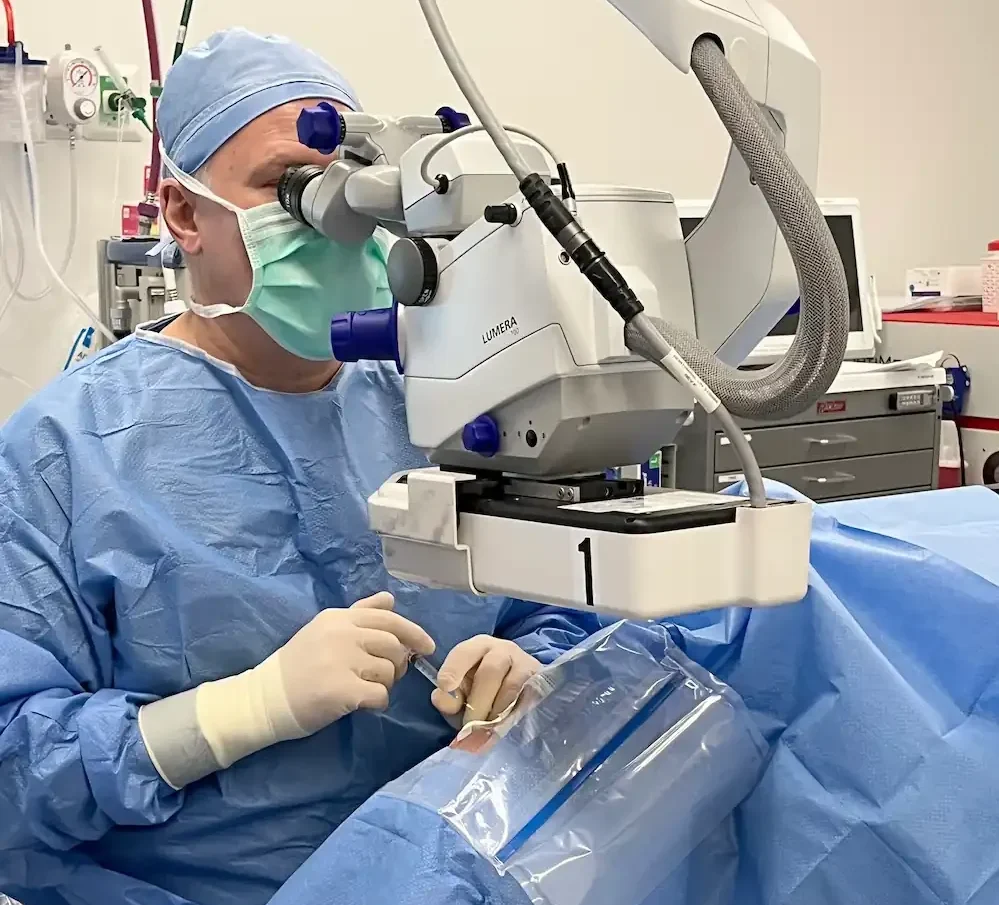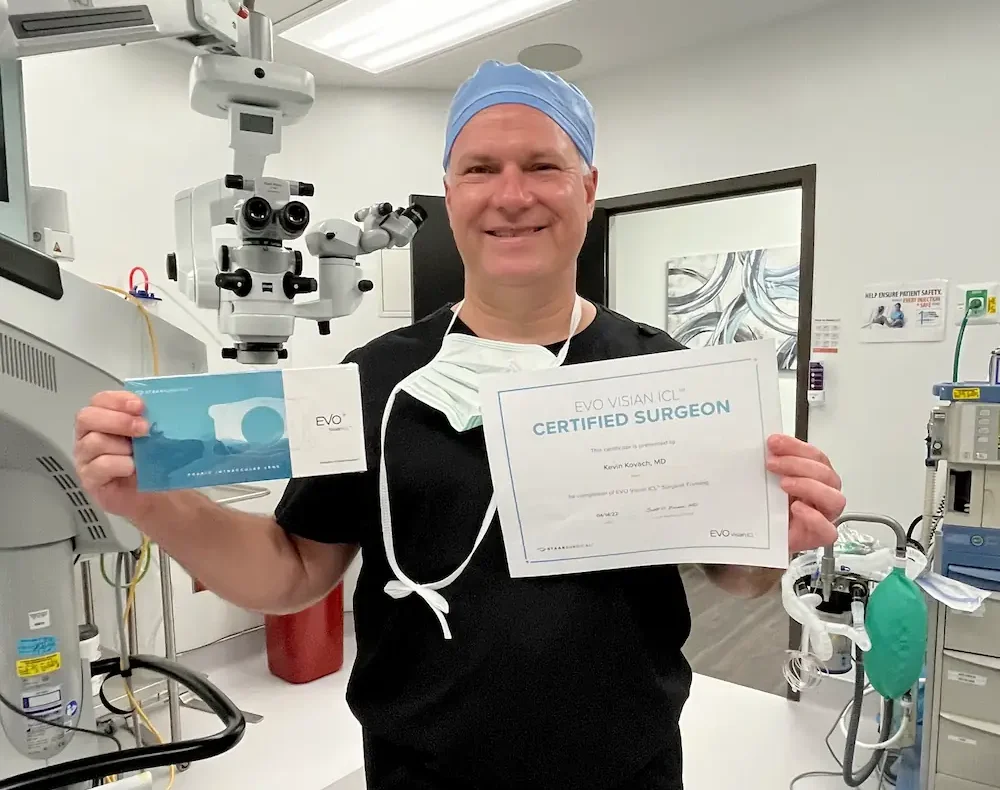EVO ICL™
Our goal at Kovach Eye Institute in Chicago is to provide each patient with fully customized vision correction, specifically tailored to their unique needs, goals, and lifestyle. One option we are especially excited to offer is the EVO ICL Lens. The EVO ICL is an innovation in vision correction that can help patients achieve significantly improved vision even if they are
Trusted Source
Phakic intraocular lens implantation in United States military warfighters: a retrospective analysis of early clinical outcomes of the Visian ICL
Parkhurst GD, Psolka M, Kezirian GM
Go to Source
not candidates
for other procedures like LASIK because they have thin corneas.


At Kovach Eye we believe in vision without limits.
Are you a candidate for vision correction surgery? Take our LASIK self-test to see if it’s a good fit!
What is EVO ICL?
The EVO is a very thin Implantable Collamer® Lens implant that works in harmony with the human eye. This lens is implanted into the eye to correct common refractive errors like nearsightedness (myopia) and astigmatism without the removal of corneal tissue. The EVO ICL is a good option for patients who may not qualify for LASIK or PRK because they have thinner corneas or severe myopia. This lens is also
Trusted Source
Comparison of implantable collamer lens (ICL) and laser-assisted in situ keratomileusis (LASIK) for low myopia
Sanders D, Vukich JA
Go to Source
removable
, provides the eye with UV protection, and allows our patients to enjoy significantly improved vision, often without the need for eyeglasses or contact lenses.
The ICL was first introduced in 1997, and the technology has evolved since then. To date, more than 1 million EVO ICL lenses have already been implanted across the globe.
Benefits of EVO ICL
Our patients derive so many benefits from the EVO ICL, including:
-
Trusted Source Visual performance after implantable collamer lens implantation and wavefront-guided laser in situ keratomileusis for high myopia Igarashi A, Kamiya K, Shimizu K, Komatsu M Go to Source Clear, sharp vision
- Effective treatment of nearsightedness (myopia)
and astigmatism - A fast, comfortable procedure
- Short recovery time
- Works in harmony with the natural eye, 100% biocompatible
- Reversible if needed
- Built-in UV protection
- No permanent changes to the eye’s structure
- Suitable for patients with
Trusted Source Management of myopic astigmatism with phakic intraocular lens implantation Gimbel HV, Ziémba SL Go to Source thin corneas
-
Trusted Source Matched population comparison of visual outcomes and patient satisfaction between 3 modalities for the correction of low to moderate myopic astigmatism Ganesh S, Brar S, Pawar A Go to Source Does not cause dry eye syndrome, like other refractive surgeries might
-
Trusted Source Effect of the EVO+ Visian Phakic Implantable Collamer Lens on Visual Performance and Quality of Vision and Life Martínez-Plaza E, López-Miguel A, López-de la Rosa A, McAlinden C, Fernández I, Maldonado MJ Go to Source Excellent night vision
Who is a Candidate for EVO ICL?
To learn whether you may be a candidate for vision correction with EVO ICL, meet with one of our ophthalmologists for a brief consultation. Ideal candidates:
- Are between the ages of 21 and 45
- Have nearsightedness or astigmatism
- Have not had a vision prescription change in the last year
- Are ready to enjoy visual freedom with reduced or even eliminated need for glasses or contacts

Preparing for EVO ICL
The key to preparing to improve your vision with EVO ICL is to attend a consultation with a Chicagoland eye doctor at Kovach Eye Institute. During this appointment, you’ll undergo an eye examination and learn more about the EVO ICL. If this is the right vision correction option for you, you will be given detailed instructions for the preparation and recovery periods.
The EVO ICL Procedure
The EVO ICL implantation procedure takes only about 20-30 minutes.
To begin, you will recline in a comfortable treatment chair while anesthetic eye drops are administered to numb your eyes, and you will be offered an oral sedative to help you relax. Your eye doctor will put a device in place to gently hold your eyes open so you won’t be concerned about blinking.
Once your comfort is ensured, your ophthalmologist will create a small opening, then insert the Implantable Collamer Lens and ensure it is positioned correctly.
You’ll spend a little time recovering at our surgery center, then you will be released to be driven home by a family member or friend.

EVO ICL Recovery and Results
Little downtime is needed after the EVO ICL procedure: many of our patients return to work within 24 hours. One of the best things about the EVO ICL is that patients notice an improvement in their vision nearly immediately.

Frequently Asked Questions About EVO ICL
Laser refractive surgeries such as LASIK and PRK work by altering the shape of the cornea to improve nearsightedness, farsightedness, and astigmatism. Thanks to advances in technology, EVO ICL allows us to improve patients’ vision without removing corneal tissue. This is why the EVO ICL is a particularly appealing option to our patients who may not be candidates for LASIK or PRK. Additionally, because no changes are made to the structure of the cornea during EVO ICL implantation, the lens can be removed should a patient’s vision needs change down the road.
Vision correction with EVO ICL is an elective procedure, which means it is rarely eligible for coverage by medical insurance.
When you come in for your EVO ICL consultation, we will go over pricing. We believe that everyone deserves visual freedom without letting financial concerns get in the way, so we offer payment and financing options.
No. Unlike a contact lens that sits on the surface of the eye, once the EVO ICL is in place, it doesn’t interact with other structures in the eye. You won’t feel it at all.
Because the EVO ICL is placed behind the parts of the eye that can be seen by other people.
Contact Kovach Eye Institute
If you live in the Greater Chicago or Chicagoland area and are ready to learn more about achieving visual freedom with the EVO ICL, contact us today to schedule a consultation with an experienced ophthalmologist at Kovach Eye Institute.

1 Parkhurst GD, Psolka M, Kezirian GM. Phakic intraocular lens implantation in United States military warfighters: a retrospective analysis of early clinical outcomes of the Visian ICL. J Refract Surg. 2011 Jul;27(7):473-81. doi: 10.3928/1081597X-20110106-03. Epub 2011 Jan 17. PMID: 21243974. Available: https://pubmed.ncbi.nlm.nih.gov/21243974/. Accessed November 28, 2022.
2 Sanders D, Vukich JA. Comparison of implantable collamer lens (ICL) and laser-assisted in situ keratomileusis (LASIK) for low myopia. Cornea. 2006 Dec;25(10):1139-46. doi: 10.1097/ICO.0b013e31802cbf3c. PMID: 17172886. Available: https://pubmed.ncbi.nlm.nih.gov/17172886/. Accessed November 28, 2022.
3 Igarashi A, Kamiya K, Shimizu K, Komatsu M. Visual performance after implantable collamer lens implantation and wavefront-guided laser in situ keratomileusis for high myopia. Am J Ophthalmol. 2009 Jul;148(1):164-70.e1. doi: 10.1016/j.ajo.2009.02.001. Epub 2009 Apr 17. PMID: 19375059. Available: https://pubmed.ncbi.nlm.nih.gov/19375059/. Accessed November 28, 2022.
4 Gimbel HV, Ziémba SL. Management of myopic astigmatism with phakic intraocular lens implantation. J Cataract Refract Surg. 2002 May;28(5):883-6. doi: 10.1016/s0886-3350(01)01098-7. PMID: 11978472. Available: https://pubmed.ncbi.nlm.nih.gov/11978472/. Accessed November 28, 2022.
5 Ganesh S, Brar S, Pawar A. Matched population comparison of visual outcomes and patient satisfaction between 3 modalities for the correction of low to moderate myopic astigmatism. Clin Ophthalmol. 2017 Jul 3;11:1253-1263. doi: 10.2147/OPTH.S127101. PMID: 28740361; PMCID: PMC5505606. Available: https://pubmed.ncbi.nlm.nih.gov/28740361/. Accessed November 28, 2022.
6 Martínez-Plaza E, López-Miguel A, López-de la Rosa A, McAlinden C, Fernández I, Maldonado MJ. Effect of the EVO+ Visian Phakic Implantable Collamer Lens on Visual Performance and Quality of Vision and Life. Am J Ophthalmol. 2021 Jun;226:117-125. doi: 10.1016/j.ajo.2021.02.005. Epub 2021 Feb 9. PMID: 33577790. Available: https://pubmed.ncbi.nlm.nih.gov/33577790/. Accessed November 28, 2022.
The doctors at Kovach Eye Institute have either authored or reviewed and approved this content.
Page Updated:



